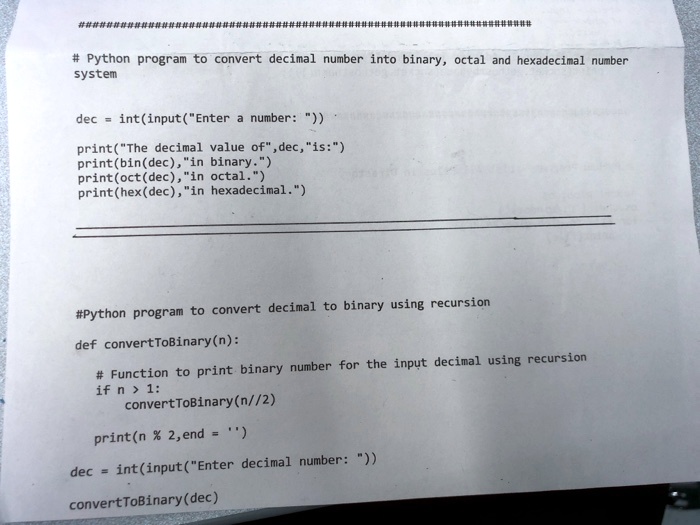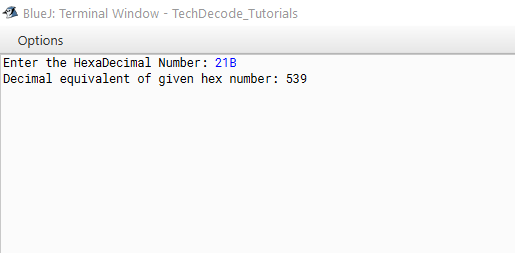
convert hex decimal python
Converting Hexadecimal to Decimal in Python: A Beginner's Guide

Source: aruljohn.com
Hey everyone! Ever wondered how computers handle those funky hexadecimal numbers? (They're like a secret code!). Let's crack the code and learn how to convert them to regular, everyday decimal numbers using Python.
What is Hexadecimal?
Hexadecimal (often shortened to hex) is a base-16 number system. It uses 16 digits, 0-9 and A-F. (A represents 10, B 11, and so on.)
- Why use hex? It's compact! (Handy for representing large binary numbers)
- Where do you see hex? Everywhere in computer science! (Imagine computer memory addresses, colours in websites, it's super important).
What is Decimal?
Decimal is our regular base-10 number system. (Like 1, 2, 3…). This is what we use every day for everyday math.

Source: googleusercontent.com
Why Convert Between Hex and Decimal?
Understanding conversions helps you relate and visualize data that is given to us by the computer in an alternative system!
The Python Approach to Conversion
Python makes hex conversions super easy. (Let's check how we do it step by step)
Method 1: Using the int() function
This method is the most straightforward!
- Input the hexadecimal number. Store it as a string. (Because Python works best with strings!)
- Specify the base. In Python,
int("yourhex", 16)is the keyword! The 16 in here stands for the base – 16. (That is important for the computer to understand where are we going!) - Print or display the output (Decimal). Let's show this. (Your regular decimal result will be seen!)
hex_num = "1A" # Example Hexadecimal number. Let's start with something easy to visualize.
decimal_num = int(hex_num, 16)
print(f"The decimal equivalent of {hex_num} is: {decimal_num}")
Example Walkthrough: Hex 1A to Decimal
Let's say we want to convert 1A to decimal using the Python function!
- Grab the
1A(hex). - Apply
int('1A', 16)in the python command line. - Check the return result : Output 26 (Decimal number). Voila. The result is 26 in decimal!

Source: numerade.com
More Examples
hex_num = "FF"
decimal_num = int(hex_num, 16)
print(decimal_num) # Output : 255
hex_num = "ABC"
decimal_num = int(hex_num, 16)
print(decimal_num) #Output : 2748
These conversions work beautifully with all kinds of hex numbers.
Advanced Conversion with Different Bases
We can easily play around with changing different base numbers. Try entering a 8 or 2 or any base (e.g. 2 is binary code)
binary_number = "1010" # Example Binary Number
decimal_number = int(binary_number, 2) # Specify base to be 2 in the method int
print(f"The decimal equivalent of {binary_number} is {decimal_number}")
#This will display 10 in the console.
octal_number = "10" # Example Octal Number
decimal_number = int(octal_number, 8)
print(f"The decimal equivalent of {octal_number} is {decimal_number}")
# This will display 8
(Did you know? Hexadecimal, decimal and binary are closely related)
Why are these Conversion Steps Important?
Knowing how to switch between hexadecimal, decimal, and binary lets you do more things!
-
Better understanding of computer systems. (These systems mostly use hexadecimal numbers for handling computer storage, processes.)
-
Working with data representations (For data manipulation, for handling data, especially related to computers or any technology!)
-
Problem-solving and debugging (When debugging programs that work with files, data).
Questions for Thought
- What is the hexadecimal equivalent of 1000 in decimal? (Tip: Think it in reverse!)
- What bases are important in computing? (Think beyond hexadecimal, binary is important, and remember what we discussed earlier!).
Potential Challenges and Solutions
- Input errors: Make sure your input hexadecimal string has only valid hex characters (0-9, A-F). Check input validation as input validation errors are common in any programming tasks (Use error handling blocks and if statement!)!
Practical Application (Example)
Let's say you're working with color codes for a website. Hex color codes (like #FF0000) are represented in a hexadecimal format. To interpret or analyze a colour scheme correctly you'd want to look at its hexadecimal format as red in a web page design often uses hexadecimal format such as "#ff0000." To calculate different values in colour manipulation programming you might need this method and conversions.
This simple conversion lets you manipulate data much better in any data processing task.
This process allows you to work well in computer related fields such as web development, programming. (Keep in mind it has applications that range beyond the programming field to general maths knowledge for better grasping of numeric representations)
This overview offers insights into converting hexadecimal to decimal. Mastering these basic steps puts you ahead in working with numerical representations in software.
# Error handling (crucial!):
try:
hex_num = input("Enter a hexadecimal number: ")
decimal_num = int(hex_num, 16)
print(f"The decimal equivalent is: {decimal_num}")
except ValueError:
print("Invalid input. Please enter a valid hexadecimal number.")
This section included example use cases for Python error handling!
Conclusion

Source: techdecodetutorials.com
Converting hexadecimal to decimal in Python is straightforward, using Python's int() function. Now you understand an important aspect of data representation (in Python)! I encourage further exploration with Python and various other ways in converting! Happy Coding!


